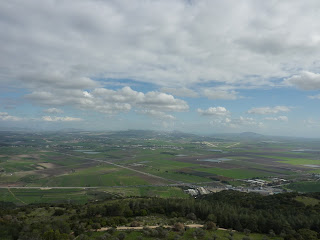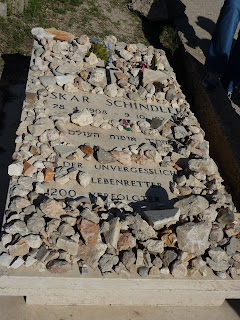TUESDAY 22nd DECEMBER.
Synopsis of day: Bus, site, bus, site, bus, Megiddo, bus, Galilee!
Spiritual Sites visited: Caesarea, Mt Carmel, Megiddo!
Biblical Connections: Acts. 1 Kings. The myriad of Megiddo ones.
Highlight of the day: I liked each of the places we visited, and I really liked taking so many beautiful pictures of Caesarea and Megiddo.
Lowlight of the day: What kind of an hour is 5am for a wake up call? Seriously? Also the hideousness that was the unexpected staircase of horror in the Megiddo water tunnel. Ack!
Favourite quote/word: “So maybe Megiddo isn't quite so awesome as it seemed before” : me during the unexpected staircase of horror in the Megiddo water tunnel interlude.
“Jesus must have been sick fit” : Kerri as we traversed even more mountains on the way to Galilee.
Favourite photo: Some of the first views of the Mediterranean at Caesarea and also some of the palm and cloud ones from Megiddo.
Cultural-shock moment: That Gila didn't think a disclaimer was necessary for the Megiddo water tunnel staircase of doom.
New food consumed: Lentil soup @ Megiddo.
Favourite purchase: Some teaching materials for Megiddo. I really wanted a Megiddo magnet though :(
The thing I lost today: my interest in Megiddo at about the time I was ready for a nanna nap.
Random act of crazy: The fact that I am known among the group as the one with “a thing for Megiddo.”
What Arthur did next: Ran ahead at Caesarea, stayed behind at the amphitheatre, disappeared when we were looking at the aqueducts and ended up on top of them.
Something I want to remember: Caesarea. (Now you were expecting a certain 'M' word, right?)
Number of times I mention Megiddo in this entry: 14, and that's just the preface.
Jerusalem @6am
This morning, our last in Jerusalem, we experienced the pain that was waking well before sunrise. But it was for a worthy cause, for we were going to Megiddo. Now I probably ought to state that I have only recently acquired knowledge concerning the awesomeness that is Megiddo. I was astounded at how many times the site features in biblical accounts, and interested in its archaeological significance as a continuously occupied site for over three thousand years BC. Kerri has found my references to Megiddo over the past few weeks an increasingly grating experience, so I think she was facing today with more dread than anticipation. (Obviously the awful start time for the day did not help matters).
In fact, the early awakening contributed to our early fizzling , meaning that from about lunch time onwards, life was just that bit more cumbersome. We drove through Jerusalem and onto Tel Aviv very quickly (and I realise it is pathetic but most of my associations with Tel Aviv are Ziva-related so I figured it was far too dangerous a place to go near :p ). By eight o'clock we had reached Caesarea. I really didn't know much about the site before my arrival there, and ended up deciding that it was a highlight of the trip. Perhaps it was the fact it was our first sight of the Mediterranean, and the gorgeous contrast of the white stone and the blue of the ocean and the sky was stunning, and a contrast from our mountainous sojourning.



The sea breeze and Roman design completely won me over, and I keep reflecting on how much the Roman lifestyle influenced the lifestyles of those within the provinces. I have taught this multiple times but never really appreciated its extent in areas apart from Gaul and Britannia. Gila was also talking on the bus about the lingua francas of the ancient world, which in the Palestine region seem to have been more affected by the Hellenic tongue than the Latin one. We got to see a video showing reconstructions of the ancient port city. From an academic perspective I enjoyed this more than any of the other audio visual we have had to this point. I especially liked hearing how the underwater blocks were orchestrated, using volcanic material from the Vesuvian region (the joys of trade among the empire). We finished by seeing the aqueducts built by Herod (could he BE any more Roman?) and of course Arthur managed to get on top of them and tramp away from the bus (any time there is a chance to go off course he does). The arches of the aqueduct against the sea were aesthetically stunning. Loved it.


We made our way inland once more, and towards the significant Jezreel valley. We climbed to the top of the Carmelite Monastery of St Elijah which had a fabulous panoramic view of the area.
It was almost a 360 degree view, this only encompasses a portion of it.
A number of people nearly fell asleep as Gila recounted the stories connected to Elijah and the region, the most famous of which being the end of the drought through the challenge to the prophets of Ba'al (1 Kings 18). Gila mentioned that Elijah was known as the “troubler of Israel” and amusingly appointed that new role to Arthur, who took it with good grace (Everyone has noticed his individualistic tendencies and most are bemused about it). The roof of the monastery had a compass like map indicating the direction of significant places around, including Megiddo.
We set off for Megiddo next, but by the time we arrived, I was really starting to feel tired, and it wasn't until I had an iced tea that I even remotely pepped up. The tell of Megiddo was interesting from a stratigraphic perspective, and although I didn't recognise many of the sites since I hadn't seen that many pictures, I found the place a delight to photograph. The colour of the sky was magnetic against the date palms.
I decided on the whole that it was not as exciting to view as it was to read about, but there is no doubting that the site has numerous biblical references, as well as being a site of supreme archaeological significance. I liked the place but probably because of how much I had enjoyed Caesarea earlier, and my increasing somnolence, it wasn't as thrilling as my other favourite Yadin excavation site, Masada.


Megiddo's favour in my eyes also had a cataclysmic moment when as part of our departure, we followed the steps of the water tunnel of Ahaz. While the first steps were steep I managed them without difficulty. That changed when the style of stairs altered, and instead of concrete we were faced with grated metal stairs. As these were probably still thirty metres from the base of the tunnel, looking down made me feel a bit queasy. Kerri did really well because she is worse with heights than me. Gila is incredibly fit and it seems like we never stop trudging except when she is lecturing, so by the time we had slowly made our way down the steps those in front of us had walked the whole distance of the tunnel to the now tepid springs.
Looking straight down was the awful bit, the rest was okay.
Though the view of water at the bottom was totally not worth it!
The memory of that staircase has somewhat soured my memory of Megiddo, but at least I still have lots of pretty pics!
We journeyed on to Galilee from there and again there were more hills than I had anticipated. Israel is not a land of (goat's) milk and (date) honey for me, instead it is a place of mountains and staircases. We arrived at our new home for the next five days at Pilgerhaus Tabgha, a German (Benedictine I think)? 'pilgrim's house'. It has been delightful so far, and I got to have fresh gluten-free bread for the first time in weeks, while they served poor Kerri-Anne a complete fish (in Kerri's words, “who serves vegetarians fish with their heads on?”) which had a quite a pungent smell. Bed that evening was a welcome relief.


























.JPG)

.JPG)
.JPG)
.JPG)
.JPG)























